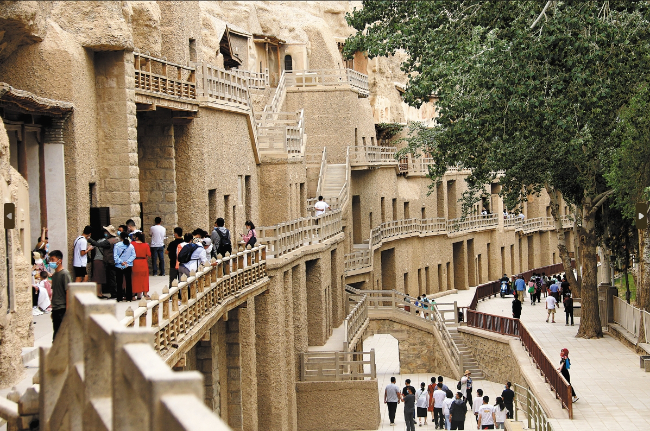Mogao Caves' preservation inspires Syrian experts

Tourists appreciate the grotto art at the Mogao Caves in Dunhuang, Gansu province, on June 21, 2022. [Photo by Zhang Xiaoliang for China Daily]
Caves inspire visitors
When it came to China's antiquities and cultural heritage, Ibrahim Kherbek, director of the DGAM's Lattakia Antiquities Department on Syria's Mediterranean coast, only knew about the Great Wall before he visited the country. He said he had never heard of Dunhuang.
However, after visiting the Mogao Caves and attending lectures by experts from the Dunhuang Academy, he expressed his astonishment at China's high level of cultural heritage preservation.
Kherbek has worked in the field of cultural heritage for over 30 years and interacts with artifacts daily. "Cultural relics have become a part of my life," he said.
The destruction and obliteration of Syrian cultural heritage by war and terrorism is heartbreaking, Kherbek said. All six UNESCO World Heritage Sites in Syria have been put on the endangered list, including the Ancient City of Damascus, which dates back to the third millennium BC and is considered one of the oldest continually inhabited cities in the world.
In 2018, seven years after the outbreak of war, Syria reopened the National Museum of Damascus and showcased artifacts that had been carefully hidden away during the conflict. "Only by eliminating war can the foundation of peace and stability be laid for cultural heritage to continue to exist," Kherbek said.
China has faced similar hardships in recent centuries when it comes to cultural preservation, enduring the ravages of imperialism and war. Countless Chinese cultural artifacts were destroyed, plundered and taken overseas, with many still unrecovered.
Yu Zongren, director of the Institute of Conservation at Dunhuang Academy, said it's hard to imagine that the well-preserved Mogao Caves were abandoned for over four centuries.
Some murals were darkened by oil lamps used for worship and cooking smoke, some Buddha statues were looted, and the lower caves were blocked by sand drifts. In the 1950s, with no electricity or cars, sand clearance relied on ox- and horse-drawn carts.
Today, the protection of the Mogao Caves involves meticulous efforts. Temperature, humidity, and carbon dioxide levels are monitored in real-time, and kiln-fired tiles have replaced cement bricks on the floor to allow for better ventilation.
To preserve the environment and microclimate, a temporary parking lot was removed by the National Cultural Heritage Administration to restore the area to its original state.
The UNESCO World Heritage Site is also embracing technology, and digitizing images of Buddha statues and murals to be shown in places outside Dunhuang.
"The prosperity or decline of civilization is closely intertwined with the stability and strength of a nation," Yu said.





 Print
Print Mail
Mail
